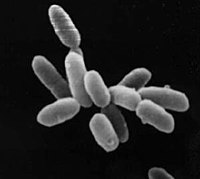 Halobacteria sp. strain NRC-1,
Halobacteria sp. strain NRC-1,each cell about 5 μm long
New Domain
Archaea were first classified as a separate group of prokaryotes in 1977 by Carl Woese and George E. Fox in phylogenetic trees based on the sequences of ribosomal RNA (rRNA) genes. These two groups were originally named the Archaebacteria and Eubacteria and treated as kingdoms or subkingdoms, which Woese and Fox termed Urkingdoms. Woese argued that this group of prokaryotes is a fundamentally different sort of life. To emphasize this difference, these two domains were later renamed Archaea and Bacteria. The word archaea comes from the Ancient Greek ἀρχαῖα, meaning "ancient things".
 Archaea were first found in extreme environments, such as volcanic hot springs. Pictured here is Grand Prismatic Spring of Yellowstone National Park.
Archaea were first found in extreme environments, such as volcanic hot springs. Pictured here is Grand Prismatic Spring of Yellowstone National Park.Species
Biology defines a species as a group of related organisms. The familiar exclusive breeding criterion (organisms that can breed with each other but not with others) is of no help because archaea reproduce asexually.
Archaea show high levels of horizontal gene transfer between lineages. Some researchers suggest that individuals can be grouped into species-like populations given highly similar genomes and infrequent gene transfer to/from cells with less-related genomes, as in the genus Ferroplasma On the other hand, studies in Halorubrum found significant genetic transfer to/from less-related populations, limiting the criterion's applicability. A second concern is to what extent such species designations have practical meaning.
The ARMAN are a new group of archaea recently discovered in acid mine drainage

No comments:
Post a Comment